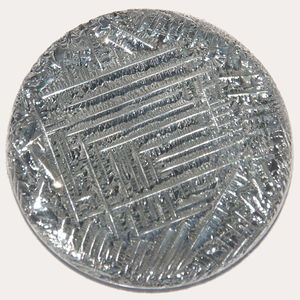Tellurium
 Metallic tellurium, diameter 3.5 cm | |||||
| General properties | |||||
|---|---|---|---|---|---|
| Name, symbol | Tellurium, Te | ||||
| Appearance |
silvery lustrous gray (crystalline), brown-black powder (amorphous) | ||||
| Tellurium in the periodic table | |||||
| |||||
| Atomic number | 52 | ||||
| Standard atomic weight (Ar) | 127.6 | ||||
| Element category | , Chalcogens | ||||
| Group, block | 16; p-block | ||||
| Period | period 4 | ||||
| Electron configuration | [Kr] 4d10 5s2 5p4 | ||||
per shell | 2, 8, 18, 18, 6 | ||||
| Physical properties | |||||
| silvery-gray | |||||
| Phase | solid | ||||
| Melting point | 722.66 K (449.51 °C, 841.12 °F) | ||||
| Boiling point | 1261 K (988 °C, 1810 °F) | ||||
| Density near r.t. | 6.24 g/cm3 | ||||
| when liquid, at | 5.70 g/cm3 | ||||
| Heat of fusion | 17.49 kJ/mol | ||||
| Heat of | 114.1 kJ/mol | ||||
| Molar heat capacity | 25.73 J/(mol·K) | ||||
| pressure | |||||
| Atomic properties | |||||
| Oxidation states | 6, 5, 4, 3, 2, 1, −1, −2 a mildly acidic oxide | ||||
| Electronegativity | Pauling scale: 2.1 | ||||
| energies |
1st: 869.3 kJ/mol 2nd: 1790 kJ/mol 3rd: 2698 kJ/mol | ||||
| Atomic radius | empirical: 140 pm | ||||
| Covalent radius | 138±4 pm | ||||
| Van der Waals radius | 206 pm | ||||
| Miscellanea | |||||
| Crystal structure | | ||||
| Speed of sound thin rod | 2610 m/s (at 20 °C) | ||||
| Thermal expansion | 18 µm/(m·K) | ||||
| Thermal conductivity | 1.97–3.38 W/(m·K) | ||||
| Magnetic ordering | diamagnetic | ||||
| Young's modulus | 43 GPa | ||||
| Shear modulus | 16 GPa | ||||
| Bulk modulus | 65 GPa | ||||
| Mohs hardness | 2.25 | ||||
| Brinell hardness | 180–270 MPa | ||||
| CAS Registry Number | 13494-80-9 | ||||
| History | |||||
| Naming | after Roman Tellus, deity of the Earth | ||||
| Discovery | Franz-Joseph Müller von Reichenstein (1782) | ||||
| First isolation | Martin Heinrich Klaproth | ||||
Tellurium is the element with symbol Te and atomic number 52.
Contents
[hide]Properties
Chemical
It is usually found in -2, +2, +4 and +6 oxidation states. It has chemical properties similar to selenium, being dissolved by sulfuric and nitric acid and potassium hydroxide solutions but not in water. It corrodes copper, iron, and stainless steel in its molten state. It reacts with oxygen in air, hydrogen, and halogens. It burns with a blueish-grey flame. Although being mildly toxic, it is infamous for making you smell really bad so don´t handle it without correct safety equipment.
Physical
Tellurium is a whitish-silvery solid, crystalline element that has a nice, metallic luster. It's a brittle and easily powdered metalloid. tellurium is a good semiconductor, and conductivity increases slightly when exposed to light. It melts at 450 ºC and boils at almost 1000 ºC.
Availability
Tellurium is one of the rarest stable elements on Earth's crust. Applications are scarce, most commonly used in electronics and solar panels. Prices are high and it has few uses for home chemists, in addition to collecting elements.
Rewritable disks contain a small layer of tellurium oxide, though you will need dozens if not hundreds to isolate a significant amount of elemental tellurium.
Tellurium is sometimes found in its native (i.e., elemental) form, but is more often found as the tellurides of gold such as calaverite and krennerite (two different polymorphs of AuTe2), petzite, Ag3AuTe2, and sylvanite, AgAuTe4.
Production
Tellurium can be prepared by reducing tellurium compounds, like metal tellurides. The procedure is very hazardous, as hydrogen telluride may form during the process. Purchasing the free element may be cheaper.
Gold, silver, copper tellurides are roasted with sodium carbonate under air at temperatures of 500 °C. The metal ions are reduced to the metals, while the telluride is converted to sodium tellurite.
- M2Te + O2 + Na2CO3 → Na2TeO3 + 2 M + CO2
Tellurites can be leached from the mixture with water and are normally present as hydrotellurites HTeO3− in solution. Selenites may also be formed during this process if any selenides are present, but they can be separated by adding sulfuric acid. The hydrotellurites are converted into the insoluble tellurium dioxide, while the selenites stay in solution.
- HTeO−
3 + OH− + H2SO4 → TeO2 + SO2−
4 + 2 H2O
Elemental tellurium is obtained by reducing the oxide either by electrolysis or by reacting the tellurium dioxide with sulfur dioxide in sulfuric acid.
- TeO2 + 2 SO2 + 2H2O → Te + 2 SO2−
4 + 4 H+
The above procedure may not work on other tellurides, like cadmium telluride.
Projects
- Make tellurium dioxide
- Make sodium tellurite
- Element collecting
Handling
Safety
Wear appropriate protection when handling it or it's compounds. Certain compounds such as cadmium telluride are highly toxic.
When small amounts are ingested, tellurium and its compounds are metabolized to dimethyl telluride, causing a foul garlic-like odor named "tellurium breath".
Storage
Tellurium should be stored in closed containers.
Disposal
Since tellurium is rare and expensive, it's best to try to recycle it.